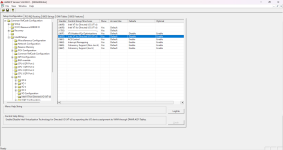cpu:Intel(R) Xeon(R) CPU E5-2698B v3
gpu:Radeon 5 320
pve version:8.3.0
kernel:6.8.12-4-pve
The BIOS options only have VMX and it's enabled
/etc/default/grub
/etc/kernel/cmdline
/etc/modules
/etc/modprobe.d/iommu_unsafe_interrupts.conf
/etc/modprobe.d/pve-blacklist.conf
/etc/modprobe.d/vfio.conf
dmesg | grep -e DMAR -e IOMMU
dmesg | grep remapping
lspci -nn | grep VGA
lspci -nnk

I've been struggling with this problem for quite some time and haven't figured out how to solve it.
gpu:Radeon 5 320
pve version:8.3.0
kernel:6.8.12-4-pve
The BIOS options only have VMX and it's enabled
/etc/default/grub
Bash:
# If you change this file, run 'update-grub' afterwards to update
# /boot/grub/grub.cfg.
# For full documentation of the options in this file, see:
# info -f grub -n 'Simple configuration'
GRUB_DEFAULT=0
GRUB_TIMEOUT=5
GRUB_DISTRIBUTOR=`lsb_release -i -s 2> /dev/null || echo Debian`
GRUB_CMDLINE_LINUX_DEFAULT="quiet intel_iommu=on iommu=pt video=efifb:off,vesafb:off pcie_acs_override=downstream"
GRUB_CMDLINE_LINUX=""
# If your computer has multiple operating systems installed, then you
# probably want to run os-prober. However, if your computer is a host
# for guest OSes installed via LVM or raw disk devices, running
# os-prober can cause damage to those guest OSes as it mounts
# filesystems to look for things.
#GRUB_DISABLE_OS_PROBER=false
# Uncomment to enable BadRAM filtering, modify to suit your needs
# This works with Linux (no patch required) and with any kernel that obtains
# the memory map information from GRUB (GNU Mach, kernel of FreeBSD ...)
#GRUB_BADRAM="0x01234567,0xfefefefe,0x89abcdef,0xefefefef"
# Uncomment to disable graphical terminal
#GRUB_TERMINAL=console
# The resolution used on graphical terminal
# note that you can use only modes which your graphic card supports via VBE
# you can see them in real GRUB with the command `vbeinfo'
#GRUB_GFXMODE=640x480
# Uncomment if you don't want GRUB to pass "root=UUID=xxx" parameter to Linux
#GRUB_DISABLE_LINUX_UUID=true
# Uncomment to disable generation of recovery mode menu entries
#GRUB_DISABLE_RECOVERY="true"
# Uncomment to get a beep at grub start
#GRUB_INIT_TUNE="480 440 1"/etc/kernel/cmdline
Code:
intel_iommu=on iommu=pt video=efifb:off,vesafb:off pcie_acs_override=downstream/etc/modules
Code:
# /etc/modules: kernel modules to load at boot time.
#
# This file contains the names of kernel modules that should be loaded
# at boot time, one per line. Lines beginning with "#" are ignored.
# Parameters can be specified after the module name.
coretemp
nct6775
vfio
vfio_iommu_type1
vfio_pci
#vfio_virqfd/etc/modprobe.d/iommu_unsafe_interrupts.conf
Code:
options vfio_iommu_type1 allow_unsafe_interrupts=1/etc/modprobe.d/pve-blacklist.conf
Code:
# This file contains a list of modules which are not supported by Proxmox VE
# nvidiafb see bugreport https://bugzilla.proxmox.com/show_bug.cgi?id=701
blacklist nvidiafb
blacklist amdgpu
blacklist radeon
blacklist snd_hda_intel
blacklist snd_hda_codec_hdmi
blacklist i915/etc/modprobe.d/vfio.conf
Code:
options vfio-pci ids=1002:6778,1002:aa98dmesg | grep -e DMAR -e IOMMU
Code:
[ 0.000000] Warning: PCIe ACS overrides enabled; This may allow non-IOMMU protected peer-to-peer DMA
[ 0.142983] DMAR: IOMMU enableddmesg | grep remapping
Code:
[ 0.405446] x2apic: IRQ remapping doesn't support X2APIC modelspci -nn | grep VGA
Code:
02:00.0 VGA compatible controller [0300]: Advanced Micro Devices, Inc. [AMD/ATI] Caicos XT [Radeon HD 7470/8470 / R5 235/310 OEM] [1002:6778]lspci -nnk
Code:
02:00.0 VGA compatible controller [0300]: Advanced Micro Devices, Inc. [AMD/ATI] Caicos XT [Radeon HD 7470/8470 / R5 235/310 OEM] [1002:6778]
Subsystem: Micro-Star International Co., Ltd. [MSI] Caicos XT [Radeon HD 7470/8470 / R5 235/310 OEM] [1462:3310]
Kernel modules: radeon, amdgpu
02:00.1 Audio device [0403]: Advanced Micro Devices, Inc. [AMD/ATI] Caicos HDMI Audio [Radeon HD 6450 / 7450/8450/8490 OEM / R5 230/235/235X OEM] [1002:a...
Subsystem: Micro-Star International Co., Ltd. [MSI] Caicos HDMI Audio [Radeon HD 6450 / 7450/8450/8490 OEM / R5 230/235/235X OEM] [1462:aa98]
Kernel modules: snd_hda_intel
I've been struggling with this problem for quite some time and haven't figured out how to solve it.



